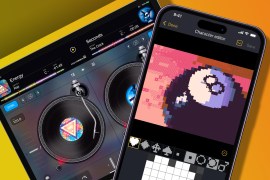Google Chromebook Pixel review
Can Google's absurdly expensive (yet utterly beautiful) ChromeBook warrant destroying your bank account? We find out
overview
Quite possibly the biggest surprise of 2013 thus far, Google’s Chromebook Pixel has appeared out of nowhere – and we’ve already got one. It takes the Chrome operating system that we last looked at on the Samsung Chromebook late last year and couples it with a more pixel-packed screen than a Retina MacBook Pro and the design philosophy of the MacBook Air. So is this the perfect combination of pixels and portability, and is the nascent Chrome OS suited to such a high-end device?
design and build
Samsung’s most recent Chromebook looked and felt like something you’d give to a child, but the Pixel is a very different and far more grown-up machine. You’d be forgiven for thinking that it’s carved from a single block of aluminium: there are no visible screws or vents, and very few join lines. The speakers are tucked away behind the keyboard, and a light strip on the back lets you know if it’s on and niftily displays the Google rainbow as it’s powering down. It’s an industrious piece of design, and the gunmetal finish makes it look more like a piece of military hardware than something you’d use to edit spreadsheets, and we rather like that.
usability
As with other Chromebooks, the keyboard layout takes a little getting used to. There’s no equivalent to the Mac Command or Windows keys, instead you’ll just find extra-long ctrl and alt buttons. Gone too is the Caps Lock button, replaced with a dedicated search key, but pressing alt and search shifts everything into capitals. The chiclet keys sit just on the right side of clacketyness; they’re positive and don’t feel like Lego bricks in a tray of treacle, unlike some rivals.
The trackpad is of the clickable-all-over variety, but despite being made of etched glass we can’t say it’s noticeably more tactile than a conventional plastic one.
screen
The screen is where the appropriately named Pixel packs its punches. It squeezes a whopping 4,352,000 pixels into a 12.85-inch display at a 2560 x 1700 resolution. That, maths-fans, gives it a density of 239 pixels per inch. It’s basically like the screen’s made from high-end smartphones, and it’s a higher density than Apple’s Macbook Pro Retina screens, which max out at 227 pixels per inch. The result is a screen that is incredibly sharp, with absolutely no aliasing. The colours make even the most lowly cameraphone pics look gorgeous, and it can be viewed from just about any angle. Google has included Tom Lowe’s 4K timelapse film Timescapes to brandish the screen, and it’s utterly astonishing – watching people’s jaws drop as they see these living photographs is almost worth the price of the device alone. Almost.
touch
Windows 8 has proved that touchscreens can have a place on laptops, and Google includes one with the pixel. The screen is Gorilla Glass-coated, so it’s robust and tactile at the same time, and despite being highly reflective the display’s sheer brightness means you can happily see everything in direct sunlight. But it doesn’t feel like the software has been built with touchscreens in mind. While the app icons at the bottom of the screen are poke-friendly, the Chrome browser and file manager are fiddlier propositions that require a more intricate level of touch interaction than our chubby digits are capable of. Unforgivably, you can’t pinch-to-zoom, which has become second nature for touchscreen devotees.
versus Macbook Air
The Chromebook Pixel’s closest competitor is Apple’s 13in Macbook Air. It packs similar components: both feature Intel Core i5 processors, 4GB RAM and Intel’s HD 4000 integrated graphics chips. Screen sizes are similar too, although the Air’s is ever so slightly bigger. The Pixel lacks the Air’s tapered approach to design, and it’s about 500g heavier. Where it really matters is in the operating system: while the Air runs OS X Mountain Lion, which is capable of running almost all Apple-compatible software, the Pixel runs the Chrome OS, which doesn’t really do anything other than Google apps.
operating system
The stripped-back nature of the Chrome OS was acceptable on Samsung’s sub-£250 Chromebook, but on the £1,000-plus Pixel it’s a massive issue. All those apps you know and love are missing: there’s no Spotify, no Steam, and no Photoshop, for example. The Chrome Web Store – where Google expects you to pick up equivalents – still looks like it’s been put together by a five-year-old, with ropey flash games taking pride of place. It seems truly bizarre given the great strides Google’s own Android operating system has made in bringing great apps to portable devices, that it’s not seen fit to do the same with its computer OS before launching such an expensive, flagship device.
storage
The standard Chromebook Pixel’s SSD contains just 32GB of storage, but this is upped to 64GB in the LTE version. That’s still low compared to the average laptop of course, but that’s sort of the point of Chromebooks – you keep everything in the cloud, and go online to do just about everything. Reinforcing this is Google’s inclusion of a whole terabyte of Drive storage – but only for three years. Thanks to its cloud-based nature and the limits on the kinds of programs and apps that are available to the Pixel you may well find that 32GB is plenty, but if the Chrome OS becomes a more fully-fledged offline operating system this could become a bigger issue.
portability
With its 3:2 aspect ratio the Pixel eschews the trend for ultra-wide laptops, and as a result it delivers a lot of screen real estate without being unmanageably large. At 1.5kg it’s not back-breaking, and thanks to its build quality we felt happy shoving it into a rucksack au naturel. Google Drive and Gmail apps are setup to run offline out of the box, so you can work on all-important documents and emails when you’re away from an internet connection, and any changes automatically sync to the cloud the next time you connect. A surprising number of Chrome apps work offline, too, including the utterly indispensable Angry Birds.
media
The Pixel’s wonderful screen is just crying out for high-definition media files to demonstrate its true glory. While our test film was rendered smoothly and in eye-popping clarity, some of the sound channels were missing in the stereo downmix, so we couldn’t hear certain pieces of dialogue. In a program such as VLC it would simply be a question of changing the audio channel settings, but there are literally no options in the Pixel’s included video player. The speakers are amazing, though; they don’t break up at higher volumes and remain crisp and defined when turned down.
connectivity
In keeping with the Pixel’s minimalist design, there are very few ports included. To the left you’ll find a pair of USB 2.0 sockets, a MacBook-style Mini DisplayPort and a headphone/microphone combination 3.5mm socket. To the right there’s an SD/MMC card reader. Bluetooth 3.0 and 802.11a/b/g/n make up the invisible connections, and there’s an LTE version in the works for on-the-go mobile internet access. It’s certainly plenty to keep you going, although the lack of USB 3.0 seems an odd omission given the price of the Pixel.
power and battery
For an ultra-portable laptop the Pixel has plenty of power, and for multi-tasking, web-browsing and video watching it operates without a stutter. It’s not going to power through the latest and greatest games, but given that none of those are available on the Chrome OS that’s not exactly an issue.
Five hours is the most you’ll get from the Pixel’s inaccessible battery pack, which is fairly understandable given the sheer number of pixels it has to push around. It means that you can never wander too far from both a power socket, though. One neat little feature is that you can attach a plug directly to the power brick, which results in a far shorter lead.
verdict
Google has absolutely nailed the Chromebook Pixel in terms of design, but the Chrome operating system still feels like it’s very much in development, and doesn’t stand a chance against Apple and Microsoft’s more established offerings. It’s far too expensive for what it is, and it’s hard to say whether it’s a step towards greater things on Google’s part or just a bit of corporate one-upmanship aimed squarely at Apple’s Macbook Air. Fingers crossed it’s more of the former than the latter, because with a more developed OS bustling with apps the Chromebook Pixel could be a real killer.
Review by Henry Winchester
Stuff Says…
The Chrome OS might be acceptable on cheap netbooks, but it seriously limits this premium ultra-portable. That screen sure is lovely, though
Good Stuff
Extra slick design
Syncs with everything Google
Highest resolution screen available
Bad Stuff
Limited Google OS
No pinch-to-zoom on touch screen
Hefty price tag


